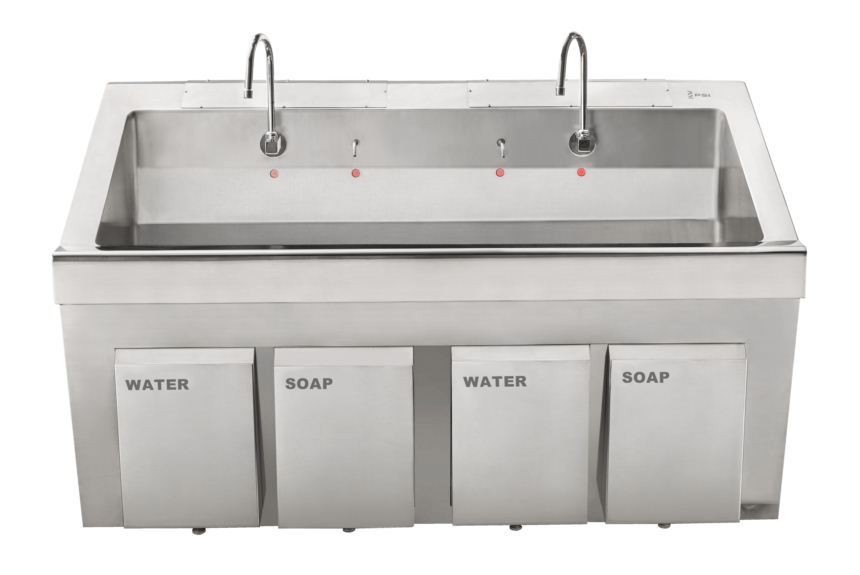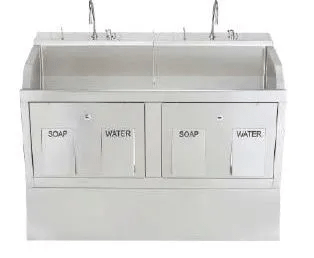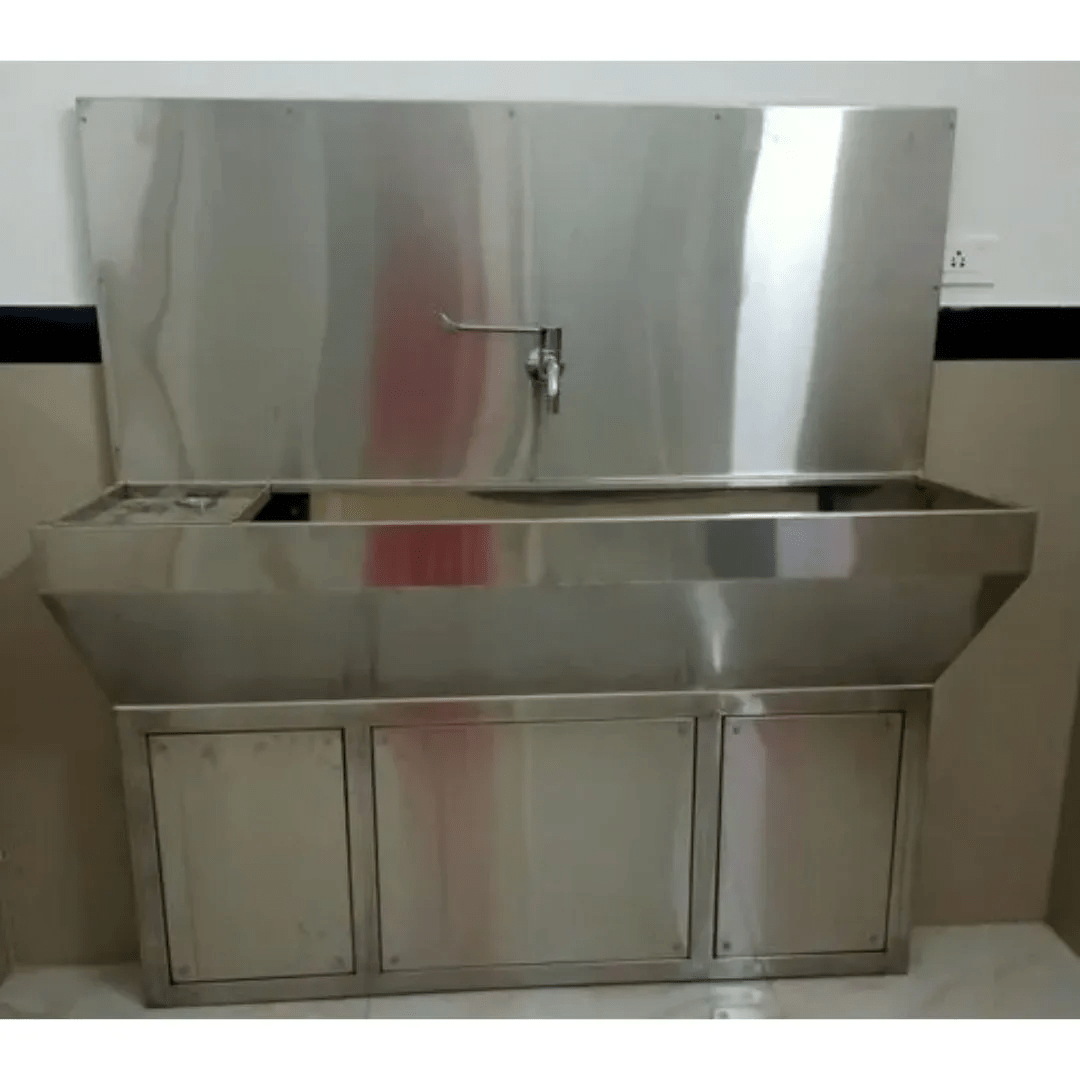In today’s medical field, nothing is without significance; even the most seemingly mundane instruments and tools hold substantial importance in terms of function and patient care. Included in this category are medical sinks, which play a critical role in hospitals and healthcare facilities.
The design of medical sinks is far from trivial. It encompasses variables such as ergonomics, functionality, safety, and aesthetics. The type of sink (single, double, or multi-station), along with its operating mechanism (foot, knee, elbow, or infrared-operated), and material (stainless steel, pedestal, deep bowl, etc.), all play vital roles in its overall performance and effectiveness in a clinical setting.
Medical sinks are crucial in preventing the spread of infections, with specific designs contributing to efficient hand hygiene practices that fight disease transmission. Furthermore, a well-designed sink facilitates optimal workflow, reducing strain on healthcare professionals and promoting orderly, streamlined operations within hospitals and clinics.
Types of Medical Sinks
Providing a cornerstone for cleanliness and infection control within medical environments, medical sinks come in myriad types based on their specific use, varying in shape, size, mechanism, and material.
- Stainless Steel Medical Sinks: Known for their robustness, stainless steel medical sinks are commonly found across healthcare facilities. They have a sturdy construction and are resistant to rust, making these sinks especially long-lasting. Additionally, their non-porous surface prevents bacteria and dirt build-up, contributing significantly towards infection control.
- Surgical Scrub Sinks: Essential for surgical environments, these sinks provide surgeons a platform for thorough pre-operation hand and arm cleaning, thus reducing the risk of infections. Most of them are equipped with specialized features like elbow-operated or foot-operated faucets to maintain hygiene. Some advanced models include infrared-operated sinks that guarantee touch-free usage.
- Hands-Free Medical Sinks: These sinks leverage sensor technology to facilitate hands-free usage, maintaining a sterile environment. Primarily used by medical staff, they enhance hygiene practices by eliminating touch points and are crucial in infection prevention.
- Pedestal Medical Sinks: Versatility defines pedestal sinks – standalone pieces that don’t occupy much space, making them perfect for small clinics or labs. They lack storage space beneath them, encouraging minimal contact and thus helping to maintain cleanliness.
- Deep Bowl Medical Sinks: Designed for heavy-duty usage, deep bowl medical sinks are perfect for accommodating large volumes of medical equipment or substances. Made typically of stainless steel, these sinks are highly durable and resistant. They find their typical use in laboratories or healthcare facilities where vast quantities of liquids need safe handling or disposal.
- Operating Room Scrub Sinks: These uniquely designed sinks are thoughtfully positioned in operating rooms. They provide a specific area for surgeons and operation staff to scrupulously scrub their hands and arms prior to any surgical procedures. The design aims to uphold a perfectly sterile environment.
- CSSD Scrub Stations: Departments of Central Sterile Services typically feature scrub sinks and stations. These areas are incredibly important because they’re where healthcare workers get ready to perform tasks related to sterile processing. Moreover, these sinks are vital in ensuring medical instruments remain clean and sterile.
- Multi-Station Operating Room Sinks: These sinks are perfect for busy areas such as operating rooms and come in a variety of setups, from 4-station to solo station. To reduce the risk of contamination and ensure hands-free operation, they come with practical features like elbow-operated, foot-operated, infrared-operated, and knee-operated controls.
- Sterile Processing Sinks: Situated in the Central Sterile Services Department, these special sinks are specially designed for washing, sterilizing, and arranging medical instruments. To keep the environment sterile while dealing with surgical tools, they might have foot-activated controls.
- Lab Scrub Sinks: You can spot these sinks in laboratories, specifically designed to make handwashing and other cleanup tasks easier for lab staff. Extra cool features might include elbow or foot controls, adding a nice touch of hygiene in the laboratory environment.
- Elbow-Operated Sinks: These sinks, designed with elbow-operated controls, encourage hands-free usage. This is essential for preserving sterile conditions within healthcare environments.
- Foot-Operated Sinks: These sinks, which have been thoughtfully designed with a foot pedal for operation, let healthcare professionals start the flow of water without needing to use their hands. This clever feature helps to decrease the possibility of cross-contamination, keeping everyone healthier and safer.
- Infrared-Operated Sinks: With the help of infrared sensor technology, these sinks can sense hand movements and turn the water flow on automatically. This hands-free mechanism is quite efficient in keeping the spread of infections at bay.
- Knee-Operated Sinks: These sinks, which offer convenient knee-operated controls, provide healthcare workers with an additional hands-free option. This ensures a sanitary environment in healthcare settings. Isn’t that cool and hygienic?
All these types of sinks play a vital role in maintaining hygiene within healthcare facilities, hence the design and functionality of these sinks are of paramount importance.
Benefits of Proper Medical Sink Design
Meeting standards of medical facility design, particularly in areas like the operating room or laboratory, necessitates careful attention to medical sink design. Such design brings in a host of benefits including enhanced infection control, improved workflow and efficiency, ergonomic benefits, and easy maintenance.
- Enhanced infection control: Firstly, medical sinks designed with features such as elbow or foot-operated taps, deep bowls, and backsplashes significantly minimize the spread of infections. These designs help prevent contact between the user’s hands and the tap or sink surface, reducing the potential for cross-contamination. Furthermore, the deep bowl designs can prevent splashing, while backsplashes guard the wall against water droplets potentially carrying bacteria.
- Improved workflow and efficiency: Additionally, multi-station sinks improve workflow and efficiency in busy healthcare facilities. With multiple users being able to wash simultaneously, these sinks minimize bottlenecking around sink areas. They are especially beneficial in situations that require rapid handwashing, such as switch-outs in surgical teams during lengthy procedures.
- Ergonomic design for healthcare staff: Ergonomic sink design is beneficial for healthcare staff who often have physically demanding roles. Features like the appropriate sink heights, knee-operated functionality, and strategically placed soap dispensers facilitate comfort and prevent strain, leading to a healthier work environment.
- Ease of maintenance and cleaning: Lastly, medical sinks constructed from materials like stainless steel are robust, chemical-resistant, and easy to clean. This resilience ensures long-term durability against heavy usage, harsh cleaning agents, and stringent sterilization processes. Furthermore, modern medical sink designs allow easy access for deep cleaning and effective maintenance.
How to Use Medical Sinks
Proper use of medical sinks, whether they are stationed in a hospital, a medical laboratory, or a general healthcare facility, could make a significant difference in infection control. Let’s walk through the respective processes of using these sinks effectively.
Proper Hand Hygiene Techniques
Routine hand hygiene, especially in healthcare settings, cannot be overemphasized. Here are some steps to effective hand washing at a medical sink:
First off, make sure your hands are damp with warm water. Afterward, squeeze out an ample amount of soap to cover all areas of your hands. Now, rub your palms together to work up a nice lather. Don’t forget to scrub in between your fingers and even under your nails. Once you’re done, rinse your hands very well. Finish off by patting your hands dry with a paper towel. Voila! Your hands are clean!
Steps for Surgical Scrubbing
Special attention to detail is needed when it comes to performing a surgical scrub:
- Begin by washing hands and forearms with an approved antiseptic
- Scrub each side of each finger, between the fingers, and the back and front of the hand for two minutes
- Proceed to scrub the arms, doing one-third at a time, for two minutes
- Rinse hands and arms by allowing water to drip from the elbow
Utilizing Foot-operated or Knee-operated Controls
Foot-operated or knee-operated sinks enable hands-free operation, ensuring higher levels of cleanliness. Simply step on the lever or press with your knee to get the water flowing.
Efficient Use of Scrub Stations
Scrub stations can be optimized by maintaining a clean and organized station. Prepare all necessary items before starting the scrub procedure, such as a scrub brush, and make sure the sink and taps are cleaned regularly to prevent bacteria build-up.
Safety Precautions for Medical Sinks
Medical sinks, like any other vital tool in healthcare settings, require specific control measures to ensure optimal safety for users and patients.
Preventing Cross-Contamination
Cross-contamination is among the primary risks in medical environments, and sinks aren’t exempt. Medical sinks can accumulate harmful microbes over time, increasing the risk of spreading pathogens. To prevent this:
- Avoid touching sink fixtures with ungloved or dirty hands.
- Regularly clean and disinfect the sink, paying extra attention to frequently touched areas like taps and handles.
- Utilize a hands-free sink design such as a foot-operated or sensor-based model to minimize physical contact.
Maintaining Water Temperature and Pressure
Effective infection control largely depends on the proper washing of medical instruments and hands. Therefore, maintaining an optimal balance of water temperature and pressure is critical. Ensure constant routine checks on the water heater systems and pressure regulators.
Proper Disposal of Biohazardous Materials
Garnishing the sink with biohazardous materials can lead to monumental problems. Establish standardized protocols for the disposal of such materials, ensuring they never come into contact with the sink.
Regular Cleaning and Disinfection Routines
Regular cleaning routines minimize microbial load and infection spread. Endeavor to use hospital-grade disinfectants, while also scheduling routine deep-cleaning sessions to maintain a hygienic sink environment. Basic etiquette like not leaving dirty instruments in the sink also contributes significantly.
Common Issues and Solutions with Medical Sinks
Medical sinks, like any other piece of practical equipment, face their own set of challenges. The following are examples of common issues that professionals often confront, along with potential solutions:
Clogging and Drainage Problems
One frequent issue with medical sinks is clogging. This can occur due to particles and debris, such as food waste, hair, or dirt, getting stuck in the pipes. The result is a buildup of water within the sink, which poses a considerable infection risk in a healthcare setting. Regular maintenance and professional cleaning can help to prevent this problem.
Leaks and Water Pressure Issues
Leaking water can lead to wasted resources and potential water damage in the facility. These leaks often occur due to worn-out seals or damaged pipes. Similarly, when the water pressure is too high or too low, the functionality of the sink decreases. Regular infrastructural checks and early repairs are necessary to address these issues.
Malfunctioning Controls and Sensors
In modern medical sinks, touchless technology is prevalent for improved hygiene. However, sensors can malfunction due to prolonged use or technical glitches, leading to a lack of water flow. Regular calibration and monitoring can help to rectify this issue.
Solutions and Troubleshooting Tips
- Regular inspections: Set up a routine check on the medical sinks to spot potential problems early.
- Frequent professional maintenance: Employ professionals to perform regular deep cleans of the system, thus maintaining optimal functionality.
- Use of quality parts: Poor quality components may lead to frequent breakdowns. High-quality materials ensure the longevity and reliability of the sink.
Recognizing these common problems and implementing these solutions will greatly enhance the functionality and longevity of your medical sinks, ultimately leading to improved patient care and safety.
Disadvantages of Improper Medical Sink Design
The design of medical sinks carries significant impacts. If overlooked or poorly dealt with, it can introduce a number of adverse consequences. Here, we delve into several potential problems associated with improperly crafted medical sinks.
- Increased Risk of Healthcare-Associated Infections: The primary purpose of medical sinks is to harbor effective infection control practices. An ill-designed sink can potentially breed an environment suitable for microbial growth, thus increasing the probability of healthcare-associated infections (HAIs). Standing water in a poorly draining sink, for example, can encourage bacterial proliferation.
- Additionally, a sink without splash-back protection may spread pathogens around the area, leading to cross-contamination. Furthermore, sinks manufactured from materials that are not easy to sterilize contribute to the long-term survival of pathogens.
- Workflow Disruptions and Inefficiencies: The position and functionality of medical sinks can directly influence the workflow. If positioned in an inconvenient location, it can cause unnecessary movement and time wastage for healthcare professionals, thereby interrupting regular protocols and hampering efficiency.
- Potential Impact on Staff Ergonomics and Comfort: Lastly, improper sink design can also pose ergonomic challenges for healthcare staff. For instance, sinks that are too high or too low can cause uncomfortable postures, leading to long-term musculoskeletal issues. Faucets that are difficult to operate or sink with sharp edges can also cause physical discomfort or injury, affecting staff morale and longevity in the profession.
Factors to Consider in Medical Sink Design
Medical sinks play a surprisingly critical role in healthcare, where they prove essential in preventing infection spread and facilitating optimum clinic, hospital, or diagnostic center operations. When selecting the perfect sink for medical use, the following factors must be carefully considered:
- Size and number of stations needed
- Faucet and control options
- Compliance with infection control guidelines
- Integration with other medical equipment
Maintenance of Medical Sinks
The function and longevity of medical sinks heavily hinge on the level and quality of maintenance they receive. Proper maintenance not only enhances sink performance but also safeguards the health of individuals who interact with this equipment regularly.
Regular Cleaning and Disinfection Protocols
Routine cleansing and disinfection of medical sinks are paramount in healthcare settings. It is vital that these sinks remain sterile to prevent the spread of infections. Recommendations include:
- Disinfecting sinks frequently, especially after contamination-prone procedures
- Cleaning grates and strainers regularly to prevent the build-up of pathogens
- Using industry-standard disinfectants to ensure corrective removal of microbes
Routine Inspections and Repairs
Regular assessments and timely repairs can identify minor issues before they balloon into major problems. Staff should look for:
- Signs of leaks
- Drainage issues
- Damage to faucets and other fixtures
Replacing Worn-Out Components
The servicing of fleeting parts, such as sealants, can extend the lifespan of a sink and improve its functionality. This can involve:
- Replacing worn-out valves and washers
- Fitting in new faucets or foot pedals
Engaging Professionals in Complex Maintenance Tasks
Remember, not all maintenance tasks can be handled in-house. When complex issues arise, it might be necessary to engage experienced professionals who specialize in maintaining medical sinks. They can undertake tasks like revamping whole sink units, installing advanced features, or modifying sink designs to enhance their efficacy and utility.
Medical Sinks From Top Leading Manufacturers
CSSD Scrub Sink Double Station
The CSSD Scrub Sink Double Station, a high-quality medical sink, is the result of the excellent manufacturing prowess of Palakkad Surgical Industries Pvt. Ltd. Recognized as a trusted name in the medical industry, the company specializes in creating top-notch products that offer lasting value. With SS 304 as the construction material, the CSSD Scrub Sink Double Station guarantees robust strength, ideal for daily use in the high-stress environment of a healthcare facility. The sink’s hands-free operation, made possible through its knee-operated feature, bolsters the cleanliness and sterility of the medical setting, making it indispensable for hospitals striving to enhance infection control.
Knee Operated Surgical Scrub Sink – Two Station
In order to address the diverse needs and requirements of healthcare facilities, PMT Healthcare Private Limited introduces the Knee Operated Surgical Scrub Sink – Two Station. As a top-tier manufacturer, PMT Healthcare continues to deliver top-quality medical sinks that meet high standards and exceed expectations. The two-station sink, made of stainless steel 304, is not just a testament to the company’s commitment to quality but also a reflection of its dedication to offering efficient and hygienic solutions to the medical world.
Sluice Sink
![]() The Sluice Sink, another quality product by Olive Health Care, successfully marries functionality with superior quality standards. Olive Health Care, a leading medical sink provider, is recognized for its ability to offer durable and cost-effective medical sinks. The sluice sink offers an effective solution for disposing of biowaste, thanks to its efficient design complete with a conical bowl, an outlet, and a flushing rim. Not just ideal for South African healthcare facilities, the Sluice Sink is also coveted by medical institutions in Nigeria and Kenya, establishing Olive Health Care as a forerunner in the medical sink manufacturing industry.
The Sluice Sink, another quality product by Olive Health Care, successfully marries functionality with superior quality standards. Olive Health Care, a leading medical sink provider, is recognized for its ability to offer durable and cost-effective medical sinks. The sluice sink offers an effective solution for disposing of biowaste, thanks to its efficient design complete with a conical bowl, an outlet, and a flushing rim. Not just ideal for South African healthcare facilities, the Sluice Sink is also coveted by medical institutions in Nigeria and Kenya, establishing Olive Health Care as a forerunner in the medical sink manufacturing industry.
Scrub Sink
The Scrub Sink by BIO-X stands out with its remarkable construction of Stainless Steel 304. Available in single, double, and triple station configurations and equipped with a variety of operational options, including manual, IR-operated, knee-operated, and foot switch-operated, it is a versatile solution for surgical handwashing needs. Suitable for hospitals, operation rooms, and various healthcare centers, the Scrub Sink is a testament to BIO-X’s commitment to delivering reliable and infection-controlled healthcare solutions.
Surgical Scrub Sink
Photon Cleantech Inc.’s Surgical Scrub Sink is a high-efficiency medical sink designed for healthcare institutions striving to maintain optimal hygiene levels. The scrub sink, complemented by an automatic sensor tap, encourages touch-free operation thereby minimizing cross-contamination risks. This feature, coupled with the sink’s high-quality stainless steel construction and user-friendly digital display, guarantees water conservation and makes this medical fixture an exceptional addition to any healthcare setting.
Conclusion
In our in-depth exploration, we’ve seen the critical importance of proper medical sink design. These specialty sinks offer a host of essential functions, from contributing to effective infection control to enhancing ergonomics and function for healthcare professionals.
The profound impact of appropriately designed medical sinks on infection control and facility efficiency cannot be overstated. They form the cornerstone of sanitary practices in a healthcare environment and help establish healthcare settings of the highest standard.
Given their crucial role, it is vital for healthcare facilities to prioritize the selection, proper usage, and maintenance of these sinks. While initial investments may seem steep, the payoff in terms of patient safety, healthcare worker satisfaction, and overall facility efficiency is truly invaluable. Every carefully designed medical sink is an investment in the continual pursuit of excellence in healthcare delivery. Let us therefore embrace the necessity, sophistication, and benefits of these indispensable tools in medical practices.





